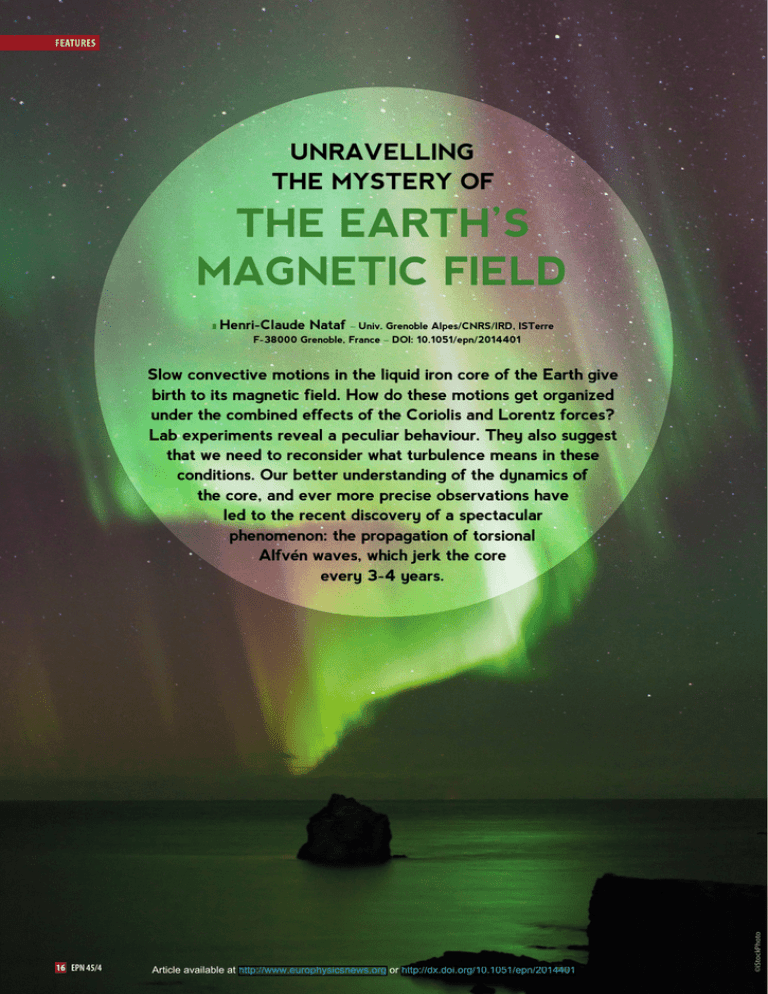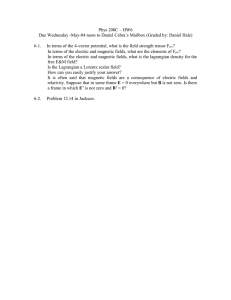Unravelling the mystery of the Earth`s magnetic field
advertisement

FEATURES UNRAVELLING THE MYSTERY OF THE EARTH’S MAGNETIC FIELD Henri-Claude Nataf – Univ. Grenoble Alpes/CNRS/IRD, ISTerre ll F-38000 Grenoble, France – DOI: 10.1051/epn/2014401 16 EPN 45/4 Article available at http://www.europhysicsnews.org or http://dx.doi.org/10.1051/epn/2014401 ©iStockPhoto Slow convective motions in the liquid iron core of the Earth give birth to its magnetic field. How do these motions get organized under the combined effects of the Coriolis and Lorentz forces? Lab experiments reveal a peculiar behaviour. They also suggest that we need to reconsider what turbulence means in these conditions. Our better understanding of the dynamics of the core, and ever more precise observations have led to the recent discovery of a spectacular phenomenon: the propagation of torsional Alfvén waves, which jerk the core every 3-4 years. The earth's magnetic field FEATURES The Earth’s remote ocean Because it is remote, invisible and unreachable, we tend to forget that the largest ocean on Earth is not at its surface: it is deep inside the Earth. The Earth’s liquid core is an ocean of liquid iron more than 2000 km thick. It lies between the central solid inner core (at radius 1220 km) and the base of the silicate mantle (at radius 3500 km). Hot as hell (T>5000°C) and under horrendous pressures (from 135 to 360 GPa), iron in these conditions is nearly as fluid as water [1]. It flows easily and, as its surface cousin, it strongly feels the rotation of the Earth: fluid motions organize in large columnar eddies with their axis aligned with the rotation axis of the Earth. These are called quasi-geostrophic motions. Purely azimuthal geostrophic motions are also expected, similar to the winds that form the bands in the atmosphere of Jupiter. There is a big difference though: fluid motions in the core generate a magnetic field, whose strength reaches 0.5 mT at its surface (down to 0.05 mT at the surface of the Earth). How? By the self-excited dynamo mechanism proposed by Larmor [2] in 1919. Take a tenuous seed of magnetic field, and let the electrically conducting liquid iron flow across its field lines. It induces electric currents. In turn, these currents generate a magnetic field. If that field reinforces the seed field, exponential growth of the magnetic field occurs. With this mechanism, it is not so easy to produce a large-scale almost dipolar magnetic field, aligned with the rotation axis, as we observe on Earth and several planets. And it was a relief when the first consistent numerical simulation of the geodynamo produced such a field, in 1995 [3]. At least as exciting were the first experimental demonstrations of dynamo self-excitation by a fluid flow, in Riga and in Karlsruhe, in the year 2000 (see [4] for an overview of dynamo experiments). azimuthal winds. The Lorentz force behaves similarly, inhibiting flows that would cross magnetic field lines. So, how do flows get organized when both rotation and strong magnetic field are present? DTS: a magnetostrophic experiment Nothing better than an experiment to explore the physics in these conditions. Take a spherical shell with a spinning inner sphere to force a spherical Couette flow, i.e., a shear flow between concentric spherical shells. Allow rotation of the outer sphere around the same vertical axis to get the Coriolis force. Add a strong dipolar magnetic field by enclosing a big magnet inside the copper inner sphere. And fill the shell with the liquid that has the largest electrical conductivity to get the Lorentz force: you get the “Derviche Tourneur Sodium” (DTS) experiment (fig. 1) that my team has built to investigate the magnetostrophic regime [5]. b Silent and invisible, the magnetic field of the Earth reveals its presence when particles from the solar wind break their way through its protective shield, producing beautiful auroras. ©iStockPhoto . FIG. 1: the DTS experiment installed in our Lab in Grenoble. The action takes place in the sphere, which contains 40 litres of liquid sodium. A changing magnetic field The magnetic field of the Earth is not static. Back in the 17th century, when maps of the magnetic field were essential for navigators, it was observed that magnetic features drift on secular time-scales. Using these long historical time series, and combining them with recent more global satellite observations, scientists infer the large-scale flow in the core. Velocities of about 1 mm/s are typical. One key observation is that magnetic energy is more than a thousand times larger than the kinetic energy of these large-scale motions. Numerical dynamo simulations are not able to reproduce this surprising result. One consequence is that the dominant forces in the Earth’s core are the Lorentz force – due to the interaction of the flow with the magnetic field – and the Coriolis force – due to the rotation of the Earth. We call this the magnetostrophic regime. We know that the Coriolis force tends to organize flows into quasi-geostrophic columns and large EPN 45/4 17 FEATURES The earth's magnetic field m FIG. 2: The initially dipolar magnetic field imposed in the DTS experiment (left) is sheared by motions in the sodium, which is dragged along by the inner sphere spinning at 30 Hz (middle; colours indicate the angular velocity of the fluid, normalized by that of the inner sphere. The values exceeding 1 in the torus correspond to super-rotation). The magnetic field lines are twisted by the flow (right). One might have expected the flow to be hindered by the Lorentz force. For the mean flow, we observe the opposite. In the absence of a magnetic field and with the outer shell at rest, viscous friction on the inner sphere drags the fluid along at angular velocities that stay below one third of that of the inner sphere Ωi. With the imposed magnetic field, the fluid spins much faster: its angular velocity even gets 20% larger than Ωi: super-rotation! It spins so fast that the Coriolis force is strong even when the outer sphere is kept at rest. We have been able to reconstruct the mean flow, using ultrasound Doppler velocimetry (sodium is opaque), and measurements of the induced magnetic field (fig. 2). Isovalues of the angular velocity tend to follow the field lines of the imposed magnetic field around the inner sphere, where the Lorentz force is the largest, obeying Ferraro’s law of isorotation. The torus drawn around the spinning inner sphere demarcates the region where sodium is super-rotating. At larger radii, the Coriolis force dominates and the mean flow is geostrophic. The field lines of the imposed dipolar magnetic field are twisted by the shear. Lessons on turbulence from experiments Our most striking observation is that turbulent fluctuations are very small despite the large values of the Reynolds number (Re~106). Under the combined action of the Lorentz and Coriolis forces, the fluid has little freedom to fluctuate. We think that this mechanism could help to explain why the large-scale magnetic energy is so large in the Earth’s core. Indeed, if the magnetic field were following a classical turbulent cascade from large scales down to small scales, where Joule dissipation occurs, one would await a total power in excess of 1000 TW, while we know that the total power transmitted by the core to the mantle is no more than 15 TW. 18 EPN 45/4 It swings in the Earth’s core Great progress has been made in reconstructing flow inside the core from the analysis of the secular variation of the magnetic field. This led to the recent discovery [6] of a spectacular ballet inside the core: geostrophic motions propagate in a wave-like fashion from the inner core to the equator of the outer core (fig. 3). The journey takes 3-4 years, and it repeats itself again and again for decades. These waves are Alfvén waves: they initiate some motion that distorts magnetic field lines, which swing back to their initial position, thus propagating the motion further. The Coriolis force inhibits Alfvén waves in the core, except for this particular kind, called torsional oscillations, on which it has no effect. The stronger the magnetic field, the faster the wave. This way, we The earth's magnetic field FEATURES anywhere. But there is still hope: our DTS experiment now has a big sister: a 3 m-diameter sphere, containing 12,000 litres of liquid sodium, which has just been launched by Dan Lathrop and his team, at the University of Maryland [4]. And we all hope that this experiment will create its own magnetic field, by the dynamo mechanism. Stay tuned! About the Author Henri-Claude Nataf studied Physics and Geophysics at the University Paris-South in Orsay, where he obtained a PhD in 1980. He is now a CNRS Research Director at ISTerre in Grenoble, where he co-founded the ‘geodynamo team’ in 1997. Acknowledgments get the first measure of the intensity of the magnetic field hidden inside the core: almost 3 mT, some six times larger than the field that makes it out of the core. Sceptical? Remember that torsional waves carry angular momentum. Since the total angular momentum of the Earth is conserved, the mantle of the Earth has to swing in the opposite direction when the wave travels. This should modulate the length-of-day, which astronomers measure very precisely. And indeed it does: the modulation is only ±0.2 milliseconds, but the prediction is right on [6]! More fun to come? It would be nice to observe these waves in our Lab experiments. Unfortunately, they are heavily damped by magnetic diffusion, and die away before they can get I thank all present and past actors of the DTS adventure for their contribution to this exciting project. Nicolas Gillet kindly provided the data used for Figure 3, and David Cébron helped with handling the Paraview software for Figures 2 and 3. References [1] Treatise on Geophysics, volume 8 Core Dynamics, Editors P. Olson and G. Schubert, Elsevier B.V. (2007) (Second Edition: 2015). [2] J. Larmor, How could a rotating body such as the Sun become a magnet? Report of the British Association for the Advancement of Science 87th meeting, 159–160 (1919). [3] G.A. Glatzmaier and P.H. Roberts, Nature 377, 203 (1995). [4] D.P. Lathrop and C.B. Forest, Physics Today 64 (7), 40 (2011). [5] D. Brito, T. Alboussière, P. Cardin, N. Gagnière, D. Jault, P. La Rizza, J.-P. Masson, H.-C. Nataf and D. Schmitt, Phys. Rev. E 83, 066310 (2011). [6] N. Gillet, D. Jault, E. Canet and A. Fournier, Nature 465, 74 (2010). . FIG. 3: Torsional waves in the Earth’s core, as discovered in 2010 by Gillet et al [6]. These geostrophic motions (arrows and colours with scale in km/year) are a particular kind of Alfvén waves. It takes them a few years (here from 1953 to 1957) to travel from the inner core to the outer core equator. EPN 45/4 19



